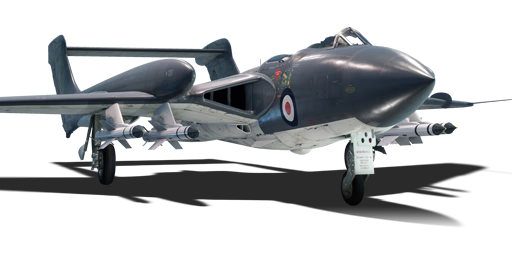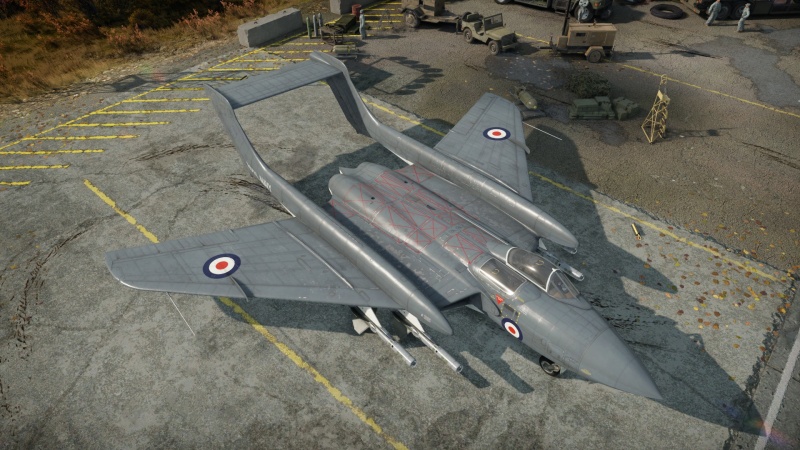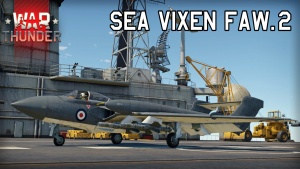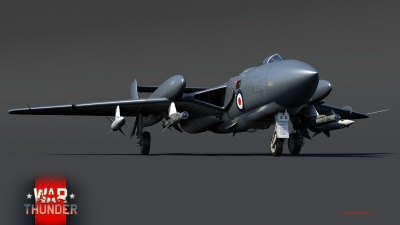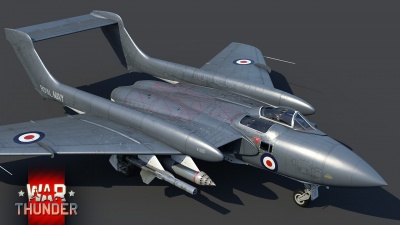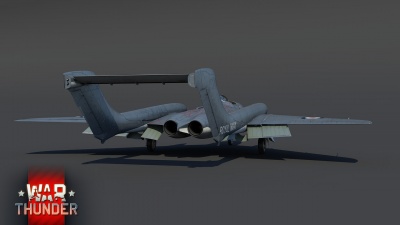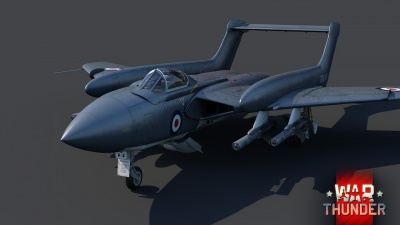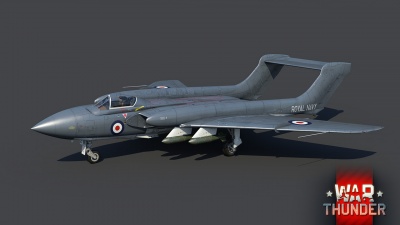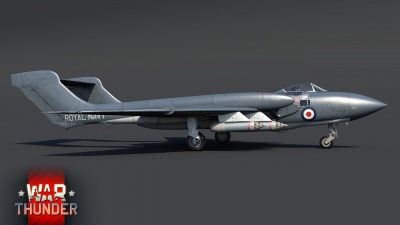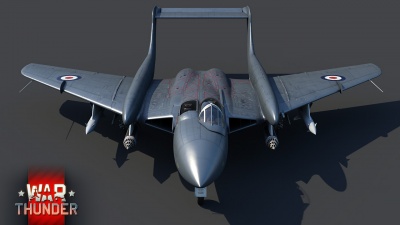Difference between revisions of "Sea Vixen F.A.W. Mk.2"
(→History: Edits) |
TigerBomber1 (talk | contribs) (→Usage in battles) (Tag: Visual edit) |
||
| Line 156: | Line 156: | ||
<!-- ''Describe the tactics of playing in the aircraft, the features of using aircraft in a team and advice on tactics. Refrain from creating a "guide" - do not impose a single point of view, but instead, give the reader food for thought. Examine the most dangerous enemies and give recommendations on fighting them. If necessary, note the specifics of the game in different modes (AB, RB, SB).'' --> | <!-- ''Describe the tactics of playing in the aircraft, the features of using aircraft in a team and advice on tactics. Refrain from creating a "guide" - do not impose a single point of view, but instead, give the reader food for thought. Examine the most dangerous enemies and give recommendations on fighting them. If necessary, note the specifics of the game in different modes (AB, RB, SB).'' --> | ||
''Describe the tactics of playing in the aircraft, the features of using aircraft in a team and advice on tactics. Refrain from creating a "guide" - do not impose a single point of view, but instead, give the reader food for thought. Examine the most dangerous enemies and give recommendations on fighting them. If necessary, note the specifics of the game in different modes (AB, RB, SB).'' | ''Describe the tactics of playing in the aircraft, the features of using aircraft in a team and advice on tactics. Refrain from creating a "guide" - do not impose a single point of view, but instead, give the reader food for thought. Examine the most dangerous enemies and give recommendations on fighting them. If necessary, note the specifics of the game in different modes (AB, RB, SB).'' | ||
| + | |||
| + | Air RB: | ||
| + | |||
| + | The Red Tops are generally much better missiles to equip, compared to the Fire streaks as they have the largest warhead of any air to air missile in game and have a slightly better top speed(2.5Mach). Because of this, the Sea Vixen's best tactic is too climb to one side at the start of the battle and attack enemy bombers. The red tops are very good for attacking from the side and this tactic is a good idea to avoid enemy tail gunners and will make your missile more likely to hit because of the red tops poor range from the rear. Alternatively, you can use the red tops in boom and zoom attacks on enemy fighters who are not watching out for missiles or fighters which have lost speed. The red tops are most useful when fired from the side between 1.0 and 2.5km range. Avoid getting into dogfights as the Sea Vixen has no cannons and it's missiles will be useless, unless you have allies to cover you or can force the enemy fighter to climb and lose speed. | ||
| + | |||
| + | Enemies worth noting: All MiG 15s and 17s as they can out turn you and a4 earlies as they have flares when fully modified, which will make your missiles redundant if used. | ||
[[File:Sea Vixen Wiki Image 4.jpg|thumb|Sea Vixen after destroying a target with its [[AGM-12B Bullpup|AGM-12B]] Bullpup.]] | [[File:Sea Vixen Wiki Image 4.jpg|thumb|Sea Vixen after destroying a target with its [[AGM-12B Bullpup|AGM-12B]] Bullpup.]] | ||
Revision as of 20:00, 23 December 2021
Contents
Description
The DH.110 Sea Vixen F.A.W. Mk.2 is a premium rank V British jet fighter with a battle rating of 8.0 (AB), 9.0 (RB), and 8.3 (SB). It was introduced in Update "Red Skies".
General info
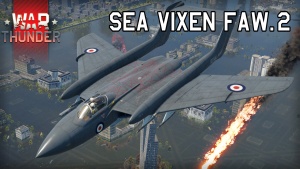
Flight performance
| Characteristics | Max Speed (km/h at 100 m) |
Max altitude (metres) |
Turn time (seconds) |
Rate of climb (metres/second) |
Take-off run (metres) | |||
|---|---|---|---|---|---|---|---|---|
| AB | RB | AB | RB | AB | RB | |||
| Stock | 1,109 | 1,093 | 13000 | 24.5 | 25.5 | 42.7 | 39.4 | 325 |
| Upgraded | 1,117 | 1,109 | 23.6 | 24.0 | 68.8 | 55.0 | ||
Details
| Features | |||||
|---|---|---|---|---|---|
| Combat flaps | Take-off flaps | Landing flaps | Air brakes | Arrestor gear | Drogue chute |
| X | ✓ | ✓ | ✓ | ✓ | X |
| Limits | ||||||
|---|---|---|---|---|---|---|
| Wings (km/h) | Gear (km/h) | Flaps (km/h) | Max Static G | |||
| Combat | Take-off | Landing | + | - | ||
| 0 | 407 | N/A | 407 | 324 | ~9 | ~5 |
| Optimal velocities (km/h) | |||
|---|---|---|---|
| Ailerons | Rudder | Elevators | Radiator |
| < 685 | < 750 | < 440 | N/A |
Engine performance
| Engine | Aircraft mass | |||||
|---|---|---|---|---|---|---|
| Engine name | Number | Basic mass | Wing loading (full fuel) | |||
| Rolls-Royce Avon Mk.208 | 2 | 12,872 kg | 291 kg/m2 | |||
| Engine characteristics | Mass with fuel (no weapons load) | Max Takeoff Weight | ||||
| Weight (each) | Type | 8m fuel | 20m fuel | 26m fuel | ||
| 2,361 kg | Axial-flow turbojet | 14,274 kg | 16,359 kg | 17,545 kg | 21,205 kg | |
| Maximum engine thrust @ 0 m (RB/SB) | Thrust to weight ratio @ 0 m (100%) | |||||
| Condition | 100% | WEP | 8m fuel | 20m fuel | 26m fuel | MTOW |
| Stationary | 5,029 kgf | N/A | 0.70 | 0.61 | 0.57 | 0.47 |
| Optimal | 5,029 kgf (0 km/h) |
N/A | 0.70 | 0.61 | 0.57 | 0.47 |
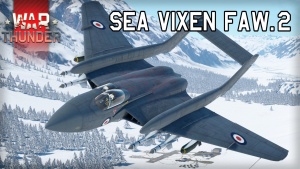
Survivability and armour
The Sea Vixen FAW.2 has no armour plates or bulletproof glass. The engines are both mounted in the centre of the airframe, with fuel tanks mainly in the wings. The tail overall is fairly weak and can be blown off easily by large calibre cannons, however the flap on the rear of the elevator can sometimes absorb shots, protecting the main elevator from damage. Unfortunately the Sea Vixen generally handles poorly when damaged, performance is reduced fairly significantly by damage to the wings and asymmetric damage can make control very difficult.
Modifications and economy
Armaments
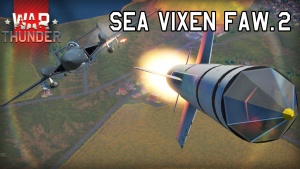
Suspended armament
The Sea Vixen F.A.W. Mk.2 can be outfitted with the following ordnance:
- 4 x Firestreak missiles
- 4 x 500 lb H.E. M.C. Mk.II bombs (2,000 lb total)
- 4 x 540 lb Mk.M1 bombs (2,160 lb total)
- 2 x 1,000 lb G.P. Mk.I bombs (2,000 lb total)
- 2 x 1,000 lb G.P. Mk.I bombs + 4 x 500 lb H.E. M.C. Mk.II bombs (4,000 lb total)
- 2 x AGM-12B Bullpup missiles
- 4 x Red Top missiles
- 144 x RN rockets
- 16 x RP-3 rockets
- 24 x AP Mk II rockets
- 2 x Firestreak missiles + 2 x AGM-12B Bullpup missiles
- 2 x AGM-12B Bullpup missiles + 72 x RN rockets
- 2 x Red Top missiles + 8 x RP-3 rockets
- 2 x Red Top missiles + 12 x AP Mk II rockets
- 2 x Red Top missiles + 2 x AGM-12B Bullpup missiles
- 2 x Firestreak missiles + 72 x RN rockets
- 2 x Red Top missiles + 72 x RN rockets
- 8 x RP-3 rockets + 2 x 500 lb H.E. M.C. Mk.II bombs (1,000 lb total)
- 12 x AP Mk II rockets + 2 x 500 lb H.E. M.C. Mk.II bombs (1,000 lb total)
- 2 x Red Top missiles + 2 x AGM-12B Bullpup missiles + 2 x 500 lb H.E. M.C. Mk.II bombs (1,000 lb total)
- 2 x AGM-12B Bullpup missiles + 72 x RN rockets + 2 x 500 lb H.E. M.C. Mk.II bombs (1,000 lb total)
- 2 x Firestreak missiles + 2 x AGM-12B Bullpup missiles + 2 x 500 lb H.E. M.C. Mk.II bombs (1,000 lb total)
- 4 x Firestreak missiles + 2 x 1,000 lb G.P. Mk.I bombs (2,000 lb total)
- 4 x Red Top missiles + 2 x 1,000 lb G.P. Mk.I bombs (2,000 lb total)
- 144 x RN rockets + 2 x 1,000 lb G.P. Mk.I bombs (2,000 lb total)
Usage in battles
Describe the tactics of playing in the aircraft, the features of using aircraft in a team and advice on tactics. Refrain from creating a "guide" - do not impose a single point of view, but instead, give the reader food for thought. Examine the most dangerous enemies and give recommendations on fighting them. If necessary, note the specifics of the game in different modes (AB, RB, SB).
Air RB:
The Red Tops are generally much better missiles to equip, compared to the Fire streaks as they have the largest warhead of any air to air missile in game and have a slightly better top speed(2.5Mach). Because of this, the Sea Vixen's best tactic is too climb to one side at the start of the battle and attack enemy bombers. The red tops are very good for attacking from the side and this tactic is a good idea to avoid enemy tail gunners and will make your missile more likely to hit because of the red tops poor range from the rear. Alternatively, you can use the red tops in boom and zoom attacks on enemy fighters who are not watching out for missiles or fighters which have lost speed. The red tops are most useful when fired from the side between 1.0 and 2.5km range. Avoid getting into dogfights as the Sea Vixen has no cannons and it's missiles will be useless, unless you have allies to cover you or can force the enemy fighter to climb and lose speed.
Enemies worth noting: All MiG 15s and 17s as they can out turn you and a4 earlies as they have flares when fully modified, which will make your missiles redundant if used.
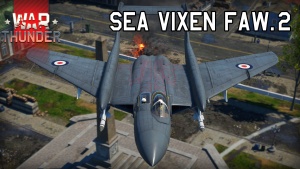
Pros and cons
Pros:
- Very high top speed of over 1,100 km/h at sea level
- Good acceleration thanks to its two powerful engines
- Red Top missiles can be very hard to dodge when used correctly
- Climbs better than most aircraft it faces
- Is surprisingly manoeuvrable
- Can carry AGM-12B Bullpup air-to-ground missiles
- Decent ground attack ordnance loadouts
- Can drop bombs / fire rockets separately instead of in pairs
- Can take-off and land from aircraft carriers
- The AI Mk.18 radar is better than that found on most aircraft you face.
Cons:
- The Sea Vixen has no guns or cannons, relying entirely on missiles for air-to-air combat
- Missiles are rear-aspect only so you cannot engage targets you are approaching head-on (or from the front aspect in general)
- Although you can use RN rockets for air-to-air they are very hard to aim and are impact fuse only
- Both Red Top and Firestreak missiles do not have great range when fired from directly behind a target.
- Only having four air-to-air missiles with no other air-to-air armament limits how many kills you can get without re-arming
- Unlike in aircraft with guns you cannot opportunistically kill ground targets while flying around
- Targets with flares can be very hard to kill
- Having only missiles enforces a fairly high minimum engagement range on you (missiles require time to start tracking after launch, and arm their proximity fuse).
History
The de Havilland Sea Vixen is a British twin-boom, twin-engine carrier air-defence aircraft employed by the Royal Navy's Fleet Air Arm from the 1950s to 1970s.
The Royal Navy had interest in a carrier defence fighter after the Second World War, and issued a requirement for such an aircraft in 1946. De Havilland began producing an aircraft, the DH 110, to fulfill this requirement. However, the Fleet Air Arm decided to proceed with the Sea Venom instead as it was cheaper and available sooner. In spite of this, De Havilland continued work on the DH 110 independently, finishing the first prototype in September of 1951. This prototype exceeded expectations and could regularly attain supersonic speeds during test flights.
Tragedy soon struck when the DH 110 prototype disintegrated in midair during the Farnborough Airshow in 1952, resulting in the deaths of 31 people including the crew of two. As a result, the DH 110 underwent significant design changes to improve its structural stability, resulting in its maximum speed being reduced to Mach 0.91. This aircraft was offered to the Fleet Air Arm and replaced the previous Sea Venoms as the RN's primary air defence fighter. In February of 1955, 110 aircraft were ordered, with the name "Sea Vixen".
The Sea Vixen was built with an unconventional twin-boom design, which de Havilland had perfected through its design of the twin-boomed Vampire and Venom fighters. The Sea Vixen was also the first British combat aircraft with no internal gun armament, relying entirely on its suspended ordnance. The FAW.1 variant was capable of carrying 4 Firestreak AAMs for fleet defence, while the FAW.2 variant could carry the more advanced Red Top missile. The aircraft had two Rolls-Royce Avon engines producing 33 kN of thrust each and a crew of two, with the pilot's canopy offset to the left and the radar operator's seat flush within the fuselage.
The first Sea Vixens entered service with frontline squadrons in 1959. The Sea Vixen failed to see any combat action during its short service, but served with the Fleet Air Arm in deployments off of Iraq, Tanganyika (part of modern-day Tanzania), Indonesia, and more. The aircraft were replaced by the more modern Phantom FG.1, a British variant of the American F-4 Phantom II. The last Sea Vixens were retired from active duty in 1972; a total of 145 were built, though 55 had been lost to accidents.
Devblog
Development of the Sea Vixen began in 1946 when de Havilland entered talks with the Admiralty on designing a future radar-equipped naval jet fighter with all-weather capability. Official requirements were drawn up in January 1947, by which time however de Havilland was already working on a design based on the preceding Vampire and Venom fighters designated DH 110.
Despite decreasing interest in the project by the late 1940's, in September 1951, the first prototype conducted its maiden flight. However, only a year later, the same prototype crashed during an air show, thus further impeding the project's progress. While the RAF abandoned the idea of purchasing the DH 110 by the mid 1950's, the FAA gained a renewed interest in the aircraft and placed an order for 110 machines to be built in February 1955. Along with the order, the DH 110 received its official designation 'Sea Vixen'.
As the Sea Vixen entered service with the FAA in 1959, de Havilland took note of the feedback gained from operational use of the aircraft and continued working on the Sea Vixen in an effort to improve its design. As a result, the Sea Vixen FAW.2 made its debut in 1962 which featured a number of improvements, of which one of the more notable ones was the ability to carry the Red Top air-to-air missiles. Over 140 Sea Vixens were built, most of which were converted over to the FAW.2 modification after its commissioning into service.
Although the British Sea Vixens never took part in any wars, they were still involved in a number of different combat operations primarily in Africa and the Middle East where they provided fire support for ground troops and flew patrols.
Media
- Skins
- Images
- Sea Vixen F.A.W. Mk.2 Devblog Images
- Videos
See also
External links
- [Development] Sea Vixen FAW.2: Breaking Convention
- Official data sheet - more details about the performance
| De Havilland Aircraft Company Limited | |
|---|---|
| Fighters | Hornet Mk.I · Hornet Mk.III · Mosquito FB Mk VI · Mosquito FB Mk XVIII |
| Jet fighters | Vampire F.B.5 · Venom FB.4 · Sea Venom FAW 20 · Sea Vixen F.A.W. Mk.2 |
| Export | ␗Mosquito FB.Mk.26 · ▄Vampire FB 52A(Italy) · ▄Vampire FB 52A(Finland) · A28B |
| Britain jet aircraft | |
|---|---|
| Blackburn | Buccaneer S.1 · Buccaneer S.2 · Buccaneer S.2B |
| British Aerospace | Harrier GR.7 · Sea Harrier FRS.1 (e) · Sea Harrier FRS.1 · Sea Harrier FA 2 |
| British Aircraft Corporation | Strikemaster Mk.88 |
| English Electric | Canberra B Mk 2 · Canberra B (I) Mk 6 · Lightning F.6 · Lightning F.53 |
| Gloster | Meteor F Mk 3 · Sea Meteor F Mk 3 · Meteor F Mk 4 G.41F · Meteor F Mk 4 G.41G · Meteor F Mk 8 G.41K · Meteor F Mk.8 Reaper |
| Javelin F.(A.W.) Mk.9 | |
| de Havilland | Vampire F.B.5 · Venom FB.4 · Sea Venom FAW 20 · Sea Vixen F.A.W. Mk.2 |
| Hawker | Sea Hawk FGA.6 · Hunter F.1 · Hunter F.6 · Hunter FGA.9 · Harrier GR.1 · Harrier GR.3 |
| Panavia | Tornado GR.1 · Tornado GR.4 · Tornado F.3 · Tornado F.3 Late |
| SEPECAT | Jaguar GR.1 · Jaguar GR.1A · Jaguar IS |
| Supermarine | Attacker FB 1 · Attacker FB.2 · Scimitar F Mk.1 · Swift F.1 · Swift F.7 |
| Foreign | Phantom FG.1 (USA) · Phantom FGR.2 (USA) · F-4J(UK) Phantom II (USA) |
| Australia | F-111C |
| India | ▄MiG-21 Bison |
| South Africa | ▄JAS39C |
| Britain premium aircraft | |
|---|---|
| Fighters | Tuck's Gladiator Mk II · ▄Boomerang Mk I · ▄Boomerang Mk II · ▄D.520 |
| ▄Martlet Mk IV · ▄Corsair F Mk II · ▄Hellcat Mk II · ▄Thunderbolt Mk.1 · ▄Mustang Mk IA | |
| Hurricane Mk.I/L FAA M · Spitfire Mk.IIa Venture I · Spitfire F Mk IXc · Plagis' Spitfire LF Mk IXc · Spitfire F Mk XIVc · Prendergast's Spitfire FR Mk XIVe | |
| Typhoon Mk Ib · MB.5 | |
| Twin-engine fighters | Hornet Mk.I · Whirlwind P.9 |
| Jet fighters | Attacker FB.2 · Hunter FGA.9 · Lightning F.53 · Meteor F Mk.8 Reaper · Sea Vixen F.A.W. Mk.2 · F-4J(UK) Phantom II · ▄MiG-21 Bison |
| Strike aircraft | ▄Wirraway · Beaufighter Mk I (40-mm) · Wyvern S4 |
| Harrier GR.1 · Strikemaster Mk.88 | |
| Bombers | ▄Avenger Mk II · ▄Boston Mk I · ▄Catalina Mk IIIa · ▄DB-7 · ▄Havoc Mk I · ▄Hudson Mk V · Swordfish Mk II |


